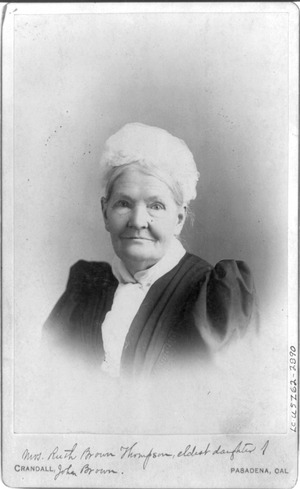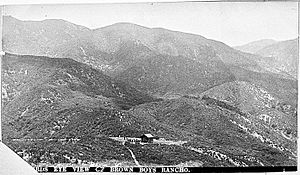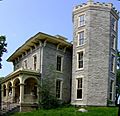Owen Brown (abolitionist, born 1824) facts for kids
Quick facts for kids
Owen Brown
|
|
|---|---|
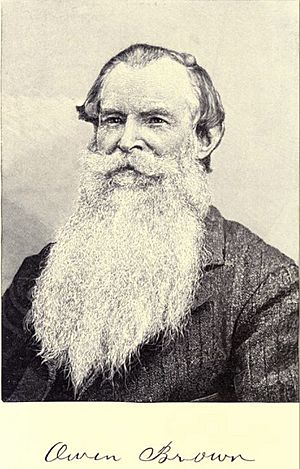
Owen Brown in 1882
|
|
| Born | November 4, 1824 Hudson, Ohio, U.S.
|
| Died | January 8, 1889 (aged 64) Pasadena, California, U.S.
|
| Resting place | A hilltop near Altadena, California, 34°13′3″N 118°9′37″W / 34.21750°N 118.16028°W |
| Known for | John Brown's raid on Harpers Ferry |
| Parent(s) | John Brown, Dianthe Lusk Brown |
| Relatives | Owen Brown (grandfather), brothers John Brown, Jr. and Jason, sister Annie Brown Adams; half-brother Watson, various other half-siblings |
Owen Brown (born November 4, 1824 – died January 8, 1889) was the third son of the famous abolitionist John Brown. An abolitionist was someone who wanted to end slavery. Owen was very involved in his father's efforts to fight slavery, more than any of his brothers or sisters.
He was the only one of John Brown's sons who took part in both the conflicts in Bleeding Kansas and his father's famous raid on Harpers Ferry. He also helped train new recruits in Tabor, Iowa, and joined his father in Chatham, Ontario, Canada, when the Harpers Ferry raid was planned. Owen was even chosen as the treasurer for the group his father led.
Contents
About Owen Brown
Owen was named after his grandfather, who was also a strong abolitionist and one of the first people to settle in Hudson, Ohio.
Owen described himself as an "engineer on the Underground Railroad". This meant he helped enslaved people escape to freedom. He also called himself a "woodsman," which meant he was very good at hiking and finding his way through forests. This skill later helped him escape after the Harpers Ferry raid.
Owen never married. He lived in a small cabin in Ohio, which he called "bachelor hall." He was deeply affected when his mother and newborn brother died when he was eight years old.
Today, Owen Brown's burial site on a hilltop near Pasadena, California, is a place that people sometimes visit.
How Owen Resembled His Father
Physical Appearance
Many people said that Owen looked the most like his father, John Brown, out of all his six adult sons. He was described as being "exactly like the portraits of his father."
In 1859, a warrant for his arrest described him as about six feet tall, with fair skin, red hair, and deep blue eyes. He was a slender man.
Owen's Arm Injury
Since childhood, Owen had an injury to his right arm that made him somewhat crippled. His father often mentioned Owen's "terrible suffering in Kansas and crippled condition from his childhood." This injury made it hard for him to do heavy work.
Personality and Character
Owen was also said to be very much like his father in his personality. He had a strong sense of purpose and was very determined. He was known for his courage and his belief in fairness and honesty.
People described Owen as a unique person. He was a mix of gentle and tough, with a warm heart. He often lived a simple, wandering life, but he never forgot his friends. He was very independent and didn't care much about what others thought of him, just like his father.
Owen's Personality Traits
- He was a kind and humorous person with an amazing memory. He could remember past events in great detail.
- He was described as gentle and modest.
- Like his brother Jason, Owen was strong, brave, and manly, but also kind and gentle.
- He was very generous, often giving what he earned to poorer neighbors and keeping very little for himself.
- He was a man of peace and held no hard feelings, even towards those who caused his father's execution.
- Owen was a strong supporter of temperance, which meant he believed people should avoid alcohol. He felt that fighting against alcohol was as important as fighting for freedom.
Fighting Against Slavery
In Kansas
Owen fought alongside his father in Bleeding Kansas, a time when there was a lot of violence between people who supported slavery and those who opposed it. His home was burned and his cattle were stolen by pro-slavery groups. He was also involved in the Pottawatomie massacre, a violent event during this period. Owen was arrested and mistreated simply because he was an abolitionist.
Harpers Ferry Raid
Owen was the only one of John Brown's children to attend the meeting in Chatham, Ontario, where the Harpers Ferry raid was planned. He was chosen as the treasurer for the group.
Before the raid, Owen spent many months exploring the mountains in the South. He was looking for safe places where enslaved people could hide if they tried to escape.
Owen participated in his father's raid on Harpers Ferry in 1859. He was guarding weapons at the Kennedy Farm in Maryland and did not go into Harpers Ferry itself. When the raid failed, Owen managed to escape capture. There was a large reward of $25,000 for his capture.
His escape was very difficult. He spent almost three months hiding and traveling at night, eating raw potatoes and corn from fields. He was often starving and his shoes wore out. Eventually, he reached Crawford County, Pennsylvania, where he had lived as a child. A Quaker family who remembered his father helped him recover. From there, he made it safely to his brother John Jr.'s home in Dorset, Ohio, about 300 miles from Harpers Ferry. Other escaped raiders also stayed there.
In 1860, Owen was accused of "conspiring with slaves to create an insurrection" by a Virginia court. The governor of Virginia offered a $500 reward for his arrest. However, the Attorney General of Ohio refused to arrest Owen and send him back to Virginia. Owen remained in Ohio for many years.
Owen was the last surviving member of the group that participated in the Harpers Ferry raid.
Life in Ohio
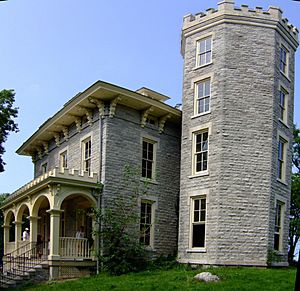
Owen didn't like to talk much about his past adventures. A reporter had to visit him many times to get him to share the story of his difficult escape.
At this time, Owen and his older brother John Jr. were farming in Put-in-Bay, Ohio. Owen lived in a small, simple cabin near his brother's house. His sister Ruth and her husband also lived nearby.
Locals thought Owen was "extremely eccentric." During the winter, and sometimes in summer, he lived alone on nearby Gibraltar Island. He was the caretaker for the home of a rich financier named Jay Cooke. Owen spent a lot of time fishing. He also studied shorthand (a fast way of writing) and copied the Bible twice using shorthand. He stayed there until 1885.
Moving to California
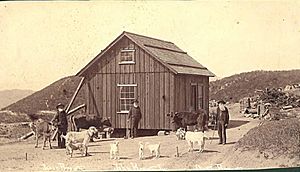
In 1885, Owen's health was not good, so he moved to Pasadena, California. His brother Jason had moved there in 1881, and his sister Ruth and her husband moved there in 1884. They wanted to get away from the negative public memory of their father. Their brother John Jr. visited but decided not to move there.
Pasadena was a city that respected John Brown's memory. Owen, Jason, and Ruth were treated like local celebrities. However, Owen found it hard to deal with the attention, so he and Jason moved to a remote cabin. Even there, tourists and friends would visit them. Some reports say they enjoyed visitors, while others say they were guides for tourists. They were often visited by a naturalist named Charles Frederick Holder, who talked with them about their experiences.
Owen and Jason earned money by selling photographs of themselves and their cabins to tourists. Their mountain cabins were only about a mile from their sister Ruth's house in Pasadena.
In 1886, during a visit by Civil War veterans to Los Angeles, Owen and Jason were honored. They were placed in a carriage, and people pulled it through the streets while a band played "John Brown's Body" and the crowd cheered. Owen gave a speech at the end.
Owen and Jason were respected by their neighbors. They were known for their generosity and for helping those who were treated unfairly. For example, when Chinese people faced boycotts in Los Angeles, Owen and Jason hired Chinese workers for their farm, even though they didn't really need the help and it was hard for them to pay. They also refused to charge interest on money they loaned. When friends collected money for them, they asked that it be sent to people affected by the 1886 Charleston earthquake instead.
About five years before Owen died, he and Jason claimed land higher up in the mountains near Pasadena. They built a cabin and cleared some land. They were working on a path up to a mountain peak, which Owen wanted to be buried on.
The people of Pasadena were very kind to them. They even raised money to help Owen and Jason buy a cow.
Temperance Movement
Owen was a very strong supporter of the temperance movement. He believed that alcohol was a greater evil than slavery, and he dedicated himself to fighting it. Owen and Jason were honorary members of the Woman's Christian Temperance Union.
Owen died of pneumonia on January 8, 1889, at his sister Ruth's home in Pasadena, California. He was 64 years old. His death was reported across the country.
Owen's Funeral and Grave
Just before he died, Owen wrote: "The only true religion is to be true to every human being, and to all animals so far as it is possible, and be just." His last clear words were: "It is better—to be—in a place—and suffer wrong—than to do wrong."
Owen's funeral was the largest ever held in Pasadena, with at least 1,800 people attending. Four ministers spoke, and a temperance speaker also gave a speech. The city leaders and students from the local academy attended. Six pallbearers (people who carry the coffin) had known John Brown. "John Brown's Body" was sung.
A marching band led a procession of 2,000 mourners, almost the entire population of Pasadena, up to Little Roundtop Hill in West Altadena. Owen had asked to be buried on this hilltop near his cabin, which offered beautiful views. The hill was later called Brown Mountain.
Years later, a gravestone was placed at Owen's grave. It read: "Owen Brown, Son of John Brown, the Liberator, died Jan. 9, 1889." It had two iron ornaments, a hook and a ring, which symbolized freedom from slavery and release from earthly life.
The gravestone disappeared in 2002 but was found a few hundred feet away in 2012. Plans were made in 2021 to put the gravestone back at the grave site.
Owen Brown in Stories and Films
- He is the narrator in Russell Banks' novel Cloudsplitter, which is a fictional story about John Brown.
- Owen Brown is a character in Ann Rinaldi’s novel Mine Eyes Have Seen, told from the viewpoint of his sister, Annie Brown.
- Actor Jeffrey Hunter played Owen in the 1955 film Seven Angry Men. This movie focuses on the discussions between Owen and his father.
- He is played by actor Beau Knapp in the 2020 Showtime TV series The Good Lord Bird, which is based on a novel.
Writings by Owen Brown
- Letter to his mother, August 27, 1856.
- Statement about Harpers Ferry, May 5, 1885.
Images for kids


